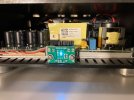- Joined
- Dec 29, 2020
- Messages
- 73
- Likes
- 34
I'm wondering if my Hypex NC252MP amplifier is overheating in its Ghent Audio case.
I bought the amplifier early this year. I left the entire system powered up 24 hours a day, even when not in use. A couple of months ago I noticed that the amplifier case was always warm to the touch, even after hours without being used. (I would say the temperature was 105 to 110 deg F; my hand was never uncomfortable on the case after extended contact.) Perhaps the amplifier case had always run warm; I never checked. I started turning the system off when not in use.
Twice in the last month or so the amplifier has malfunctioned.
Symptoms:
1. Volume of the left speaker drops to about 5% of the right speaker.
2. The sound from the left speaker is 50% music and 50% static. The static sounds exactly like a tuner set to an FM frequency on which no station is broadcasting. I take this as an indication that the amplifier module is generating white noise.
The first time this happened I didn't know whether it was the amplifier, the upstream equipment, or the speaker. I spent some time checking connections and switching input sources to the pre-amp. After about 15 minutes I tried cycling power to the entire system. At power up, the system behaved normally.
Last night, during the second malfunction, I began removing and swapping components (including cables) to isolate the malfunctioning component. The one and only constant was the left channel of the amplifier. Nothing I did made the system return to normal sound. After some time—perhaps 20 minutes, give or take—the system did return to normal sound. I noted that the amplifier case had cooled off, down very close to palm-of-hand temperature. I put all the components and cables back in their original positions, and the system ran perfectly.
I bought the amplifier early this year. I left the entire system powered up 24 hours a day, even when not in use. A couple of months ago I noticed that the amplifier case was always warm to the touch, even after hours without being used. (I would say the temperature was 105 to 110 deg F; my hand was never uncomfortable on the case after extended contact.) Perhaps the amplifier case had always run warm; I never checked. I started turning the system off when not in use.
Twice in the last month or so the amplifier has malfunctioned.
Symptoms:
1. Volume of the left speaker drops to about 5% of the right speaker.
2. The sound from the left speaker is 50% music and 50% static. The static sounds exactly like a tuner set to an FM frequency on which no station is broadcasting. I take this as an indication that the amplifier module is generating white noise.
The first time this happened I didn't know whether it was the amplifier, the upstream equipment, or the speaker. I spent some time checking connections and switching input sources to the pre-amp. After about 15 minutes I tried cycling power to the entire system. At power up, the system behaved normally.
Last night, during the second malfunction, I began removing and swapping components (including cables) to isolate the malfunctioning component. The one and only constant was the left channel of the amplifier. Nothing I did made the system return to normal sound. After some time—perhaps 20 minutes, give or take—the system did return to normal sound. I noted that the amplifier case had cooled off, down very close to palm-of-hand temperature. I put all the components and cables back in their original positions, and the system ran perfectly.


